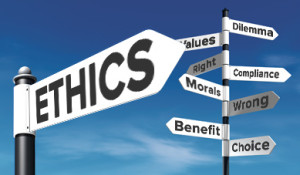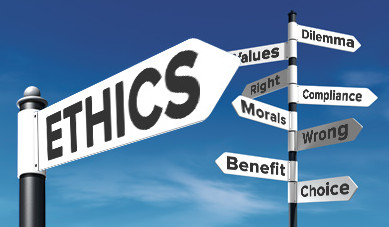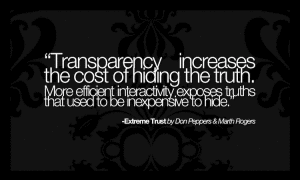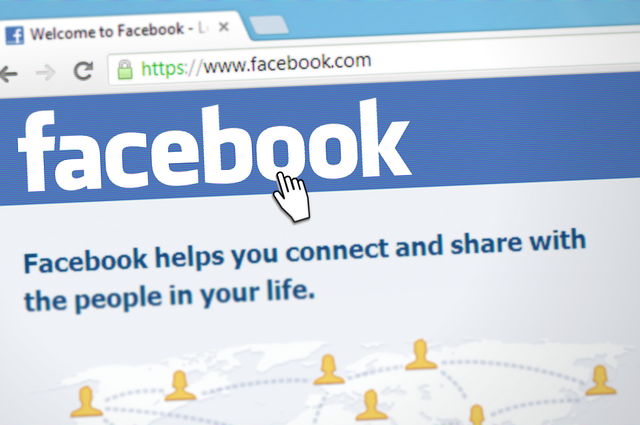By Rhianna Gelhart (@RGelhart)
 Transparency and Ethics go hand in hand when it comes to businesses and their practices. In order for a company to be transparent they must be following their ethical standards and guidelines closely. Right?
Transparency and Ethics go hand in hand when it comes to businesses and their practices. In order for a company to be transparent they must be following their ethical standards and guidelines closely. Right?
It turns out that there are some very fine lines that come along with Transparency and Ethics. For starters many companies definition of Transparency and Ethics vary, which makes for a lot of room for discrepancies. In a book written by Kelli Matthews on Strategical Social Media, she notes scholars from Brigham Young University found that some public relations managers suggest that transparency was about facts, not about the truth (Strategical Social Media by Kelli Matthews). This statement alone raises concerns simply because many consumers view transparency as the truth. If public relation firms are using transparency as a way to spin the facts in the most appealing way, then we have a big problem.
In an article written by Scott Monty for the Guardian he states the importance of authenticity in transparency thus addressing the problem between truth and facts: “Transparency gets your brand attention; authenticity allows your message to be heard and believed” (Scott Monty).
We now can draw our attention to social media and how it is affecting companies and their quest for transparency. One of the major obvious advantages of social media is its scalability – or ability for one specific piece of information to go global in less than 12 seconds. This is great for wanting to find the latest news as soon as it happens, but what does this do to a company or brand when something negative is found and retweeted, reblogged, and relived over and over again for the whole wide world to see?
There are a few classic examples of how easily a companies transparency and authenticity relating to ethics is destroyed. From Walmart’s “Working Families for Walmart” fiasco to Chrysler’s Twitter mishap, the list becomes endless due to the overwhelming ability of social media to reach the masses.
This brings me to another topic closely related to ethics: Native Advertising. Native advertising is the name for the technique that many major companies are indulging in now. It is the act of creating an article to look like a piece of news but it is actually paid for by the company it is promoting. This is seen by many as completely unethical, yet landmark publications like The New York Times are allowing it. I will end this post with John Oliver’s take on Native Advertising and the ethics involved.
To wrap up, these topics raise some important questions and concerns. Firstly, is social media a help to companies when it comes to transparency? Should certain companies be shown grace for their mishaps as we all make mistakes?
There are many ethical standards set in place by countless organizations and agencies intent on keeping businesses and their advertising content honorable but at what point does it all become a battle ground for which companies can capitalize on each others (lack of) transparency.





I think that social media is a great asset for companies looking to be more transparent. That being said, I think it depends on its usage. If you’re talking about a professional news publication, that paper would most likely put a heavy emphasis on being transparent with its audience — giving them the most accurate facts that they have at the time, not playing “gotcha” journalism, etc. I don’t think transparency is as much about truth as it is about accuracy and honesty. That plays over to other social media uses too — such as specifically being honest and transparent about your affiliations on Twitter and other platforms.
I think the question of whether or not companies should essentially be shown mercy for a mistake is a good one… I think it depends on the mistake. The Clorox tweet from class today is one example. Should Clorox be shown “mercy” or “grace” after it sent out a fairly racist tweet? Did it handle that situation honestly and transparently? Not sure. I think Clorox shouldn’t have deleted their tweet, for transparency’s sake…. But it seems, with the topic of ethics in social media, we end up with more questions than answers.
This is a great article! So relatable as it not only pertains to companies but also to us, as aspiring young professionals. I think it is definitely difficult to decide if transparency is the best choice, especially when presenting one’s company or self via social media. However, I do think an honest brand is key. By portraying an incorrect image, a consumer or potential employer will be viewing an untrue image. If a company or individual is able to be transparent and do so in a correct fashion, I believe it can really pay off and ultimately, be very beneficial. In the long run, it can help build and maintain relationships with potential and current employees, customers and consumers. I really enjoyed your take on this topic especially in relation to our lecture(s), some of the readings and a few current events.
An interesting point that you addressed from Monty’s article in the Guardian was the relationship between authenticity and transparency. I read his article and somewhat disagree with him. (Side note: I’m actually pretty surprised that was published in the Guardian because his arguments contain some holes and I also noticed a typo.) He raises the question of whether or not an organization is authentic if they’re transparent, and defines both of them as if they are two separate ideas. He says, “being authentic requires a little extra effort. More than just ensuring that access and message are on point, that the video or image or story are crafted just so, brands must ask: who are our messengers?” But I think this is a huge part of being transparent. There is really no argument to be made on whether or not transparency leads to authenticity — it 100% does. And if you’re not transparent, you’re not authentic.
I agree with Andrea. Your point on Monthy’s article on authenticity and transparency its a fine line. One the one hand it can work very well in a companies favor if it’s doing good things and pleasing a majority of consumers, making it more likely for them to be read as authentic and believable. But when something negative comes out against the company how do you address that issue without making it worse and losing credibility? The only way to be authentic and transparent is to remain so even in bad situations, because consistent transparency can help maintain believability.